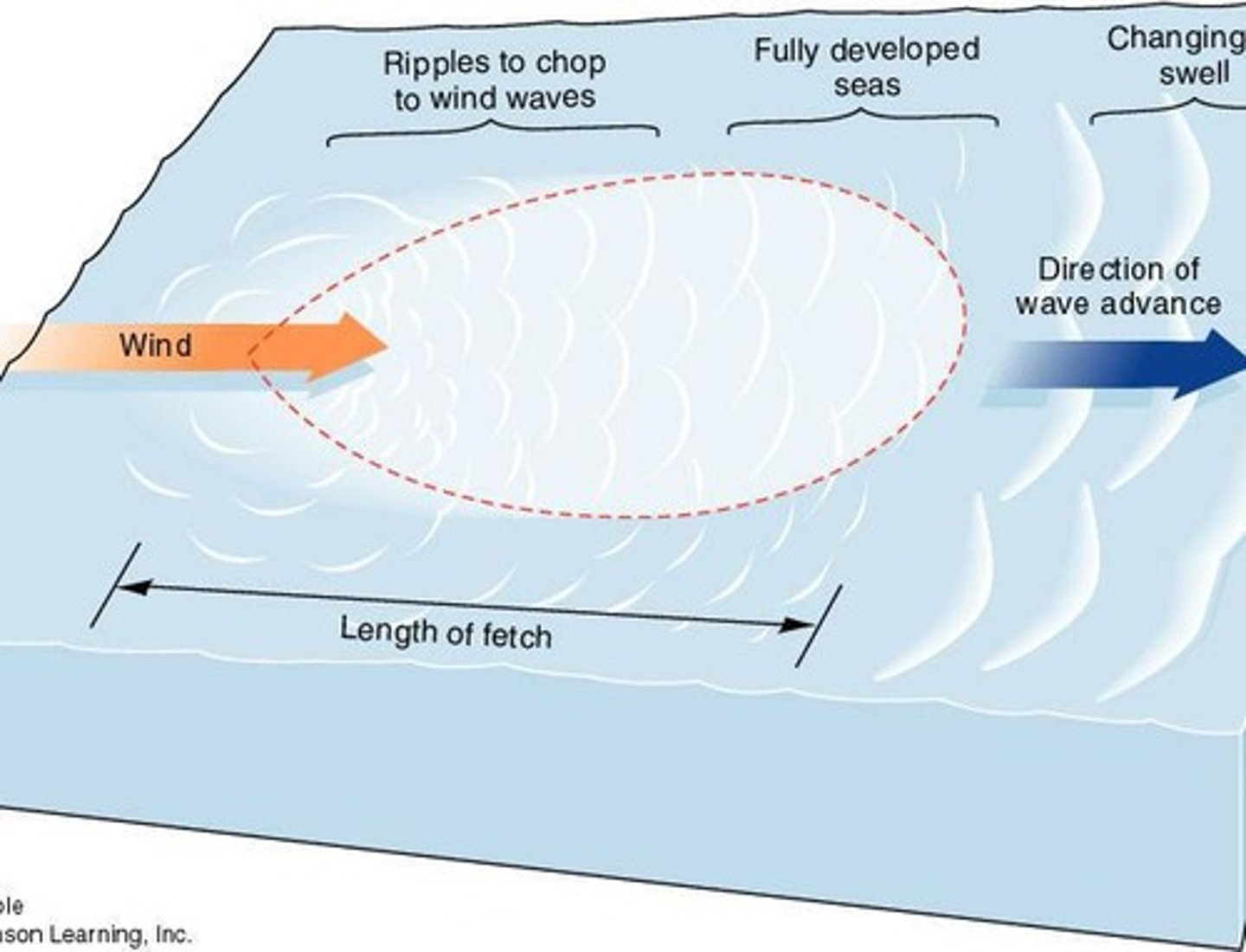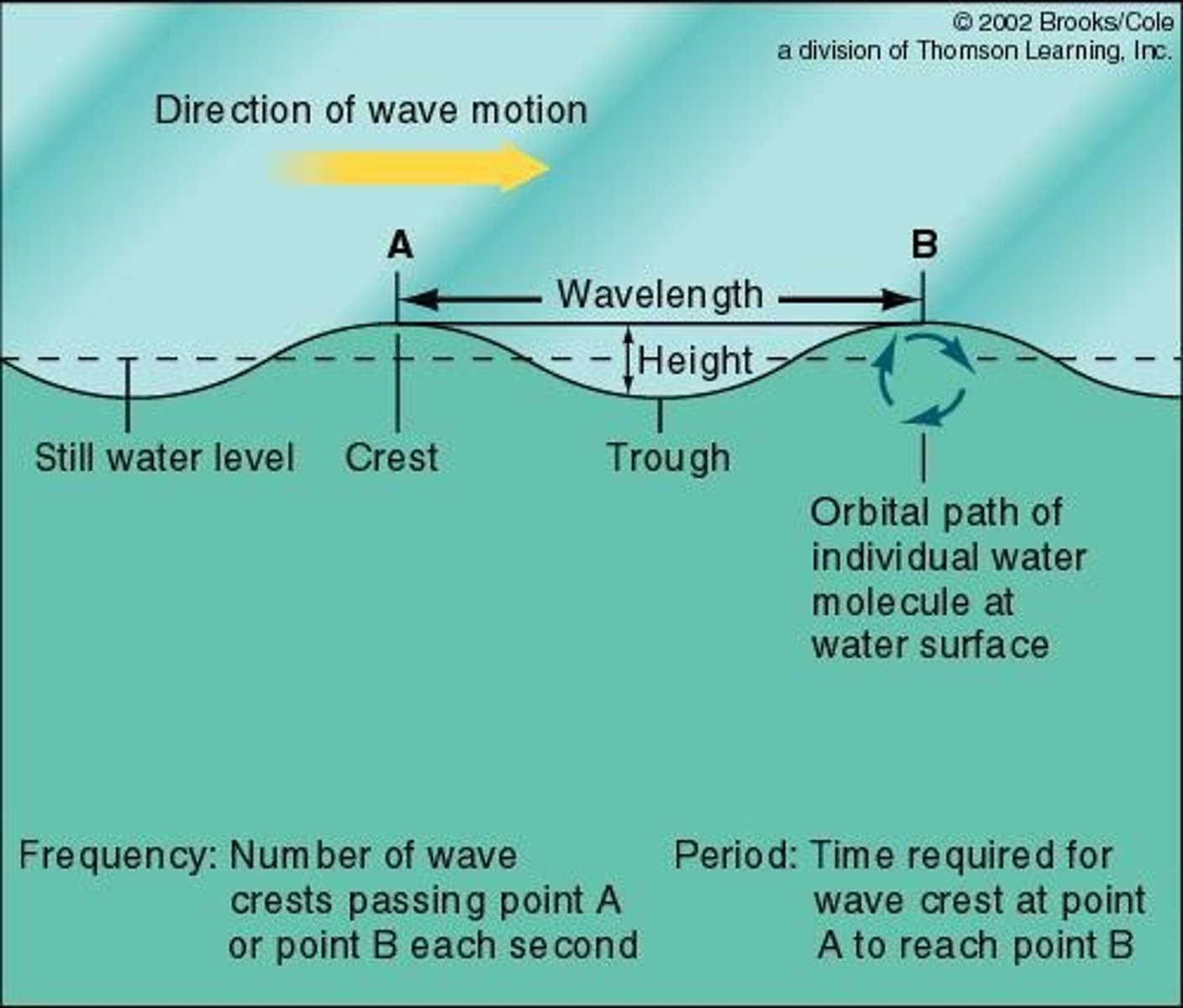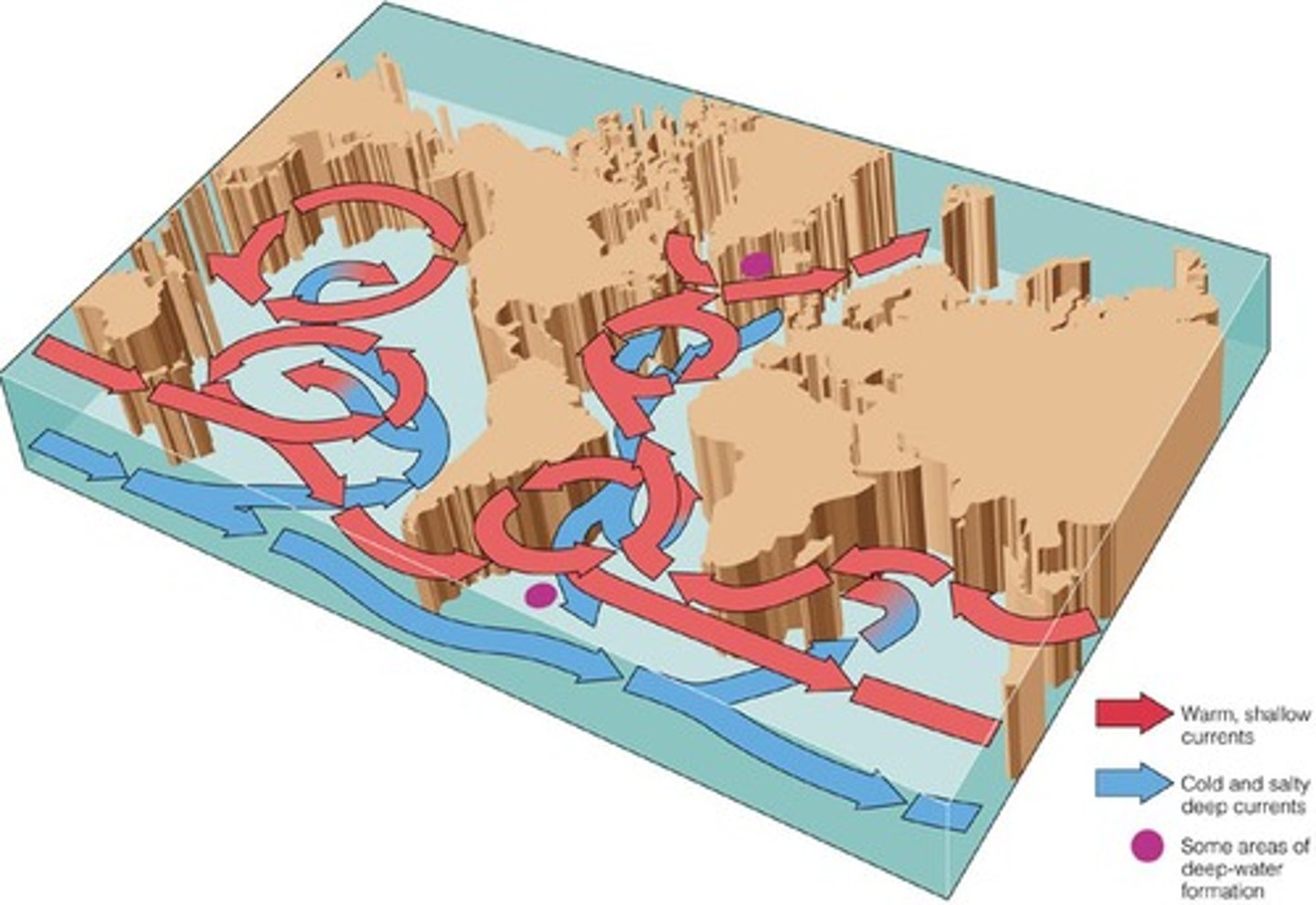Marine Biology: Waves, Tides, and Ocean Circulation Fundamentals
1/64
There's no tags or description
Looks like no tags are added yet.
Name | Mastery | Learn | Test | Matching | Spaced |
|---|
No study sessions yet.
65 Terms
What transforms wave energy as it approaches a coastline?
Wave shoaling transforms wave energy.
What happens to wave force with depth?
The force of waves diminishes with depth.
What distinguishes shallow-water waves from deep-water waves?
Shallow-water waves occur in depths less than 1/20th of their wavelength, while deep-water waves occur in depths greater than ½ their wavelength.
Why are tides considered forced, shallow water waves?
Tides are influenced by gravitational forces and occur in shallow water.
What are the three primary tidal patterns?
Diurnal, semidiurnal, and mixed-semidiurnal.
What are the two opposing forces that create tides?
The Moon's gravity and inertia.
What is a tidal datum?
A fixed reference level for measuring tide heights, commonly Mean Lower Low Water (MLLW).
What is the significance of MLLW?
MLLW is the average height of the lower of the two low tides each day, used as a standard datum for navigation.
What is the difference between perigee and apogee?
Perigee is when the Moon is closest to Earth, resulting in higher tides; apogee is when it is farthest, resulting in weaker tides.
What are spring tides?
Tides that occur during the new and full moons when the Earth, Moon, and Sun are aligned, resulting in the largest tidal range.
What are neap tides?
Tides that occur during the first and third quarter moons when the Sun and Moon are at a 90° angle, resulting in the smallest tidal range.
What role does the Sun play in tidal forces?
The Sun exerts a gravitational force that is about 46% that of the Moon, affecting tidal patterns.
What is the Coriolis Effect?
The deflection of moving water due to Earth's rotation, affecting tidal movement.
What is resonance in the context of tides?
Resonance occurs when the natural sloshing period of a basin matches the tidal period, amplifying the tidal range.
What is an amphidromic point?
A point in the ocean where the tidal wave rotates around, typically found in small bodies of water.
What is the Bay of Fundy known for?
It is the world's most extreme example of resonance, amplifying tides to a record height of 16 meters (52 feet).
What are circatidal rhythms?
Internal biological clocks with a period of approximately 12.4 hours that help organisms anticipate tides.
What are circalunar rhythms?
Internal biological clocks with a period of approximately 29.5 days that help organisms track lunar cycles.
What is the primary cause of wave generation?
Waves are primarily generated by wind.

What is the relationship between wave height and amplitude?
Amplitude is half the height of the wave, measured from the crest to the level surface.
What happens during wave shoaling?
As waves approach shore, they slow down, decrease in wavelength, and can break, forming surf.
What is the period (T) of a wave?
The time required for two successive crests or troughs to pass a given point.

How do water particles move in a wave?
Water particles move in a circular or orbital motion without significant net forward movement.

What is the effect of geography on tidal patterns?
Continents can obstruct tidal bulges, altering the magnitude and pattern of tides.
What is the significance of tidal heights being referenced to a tidal datum?
It ensures that charted depths are reliable for navigation.
What is the central question of the lecture on ocean currents?
How does energy from the sun create currents that stir the entire global ocean, from the surface to the deepest trenches?
What are the main components of the lecture roadmap?
The Energy Engine, Wind-Driven Currents, The Deep Conveyor, Synthesis & Climate.
What drives ocean and atmospheric circulation?
The Sun.
What is the effect of uneven solar heating on the ocean?
It creates a fundamental heat gradient, leading to equatorial excess and polar deficit.
How does evaporation affect surface salinity?
Evaporation in the subtropics makes water saltier and denser.
What occurs when precipitation exceeds evaporation?
Water becomes fresher and less dense, typically occurring near the equator and subpolar regions.
How do winds influence ocean currents?
Winds transfer momentum to the water through friction, creating a force called wind stress.
What is the relationship between wind speed and wind stress?
Wind stress is proportional to wind speed squared (τ ∝ U²).
What is the Ekman Spiral?
A phenomenon where surface water moves ~45° to the right of the wind in the Northern Hemisphere, creating a spiral of flow in the top ~100m.
What is upwelling?
The upward motion of water that brings cold, nutrient-rich water towards the surface.
What is downwelling?
The downward motion of water that supplies the deeper ocean with dissolved gases.
What creates coastal upwelling?
Diverging surface seawater allows deeper, cooler, nutrient-rich water to replace it.
What is the biological productivity associated with upwelling?
High biological productivity due to nutrient-rich waters being brought to the surface.
What happens during downwelling?
Surface seawater moves towards an area, piles up, and moves downward, resulting in low biological productivity.
How do ocean gyres form?
Ekman transport creates large, basin-scale ocean gyres through the convergence of water driven by trade winds and westerlies.

What are the major wind patterns influenced by temperature gradients?
Trade Winds (east to west in the tropics) and Westerlies (west to east in the mid-latitudes).
What is the role of the deep conveyor in ocean circulation?
It facilitates the global movement of deep water masses, linking wind-driven and density-driven circulation.
What are the characteristics of Western and Eastern boundary currents?
Western boundary currents are warm and swift (e.g., Kuroshio Current), while Eastern boundary currents are cold and slow (e.g., California Current).
What is thermohaline circulation?
Ocean circulation driven by density differences due to temperature and salinity variations.
What is the significance of the Inter-Tropical Convergence Zone?
It is a region where trade winds converge, influencing weather patterns and ocean currents.
What is the impact of the Coriolis effect on ocean currents?
It causes currents to be deflected, influencing their direction and creating gyres.
What is a Geostrophic Current?
A current that flows in a circle around a hill when the outward Pressure Gradient Force is balanced by the inward Coriolis effect.
How do Western Boundary Currents differ from Eastern Boundary Currents?
Western Boundary Currents are narrow, deep, and fast, while Eastern Boundary Currents are broad, shallow, and slow.
What is Western Boundary Intensification?
The phenomenon where Western Boundary Currents are intensified due to the change in Coriolis strength with latitude.
What is the significance of the convergence zone in ocean gyres?
It traps floating debris, leading to the formation of garbage patches.
What drives Thermohaline Circulation?
Gravity acting on density differences caused by temperature and salinity.
What conditions lead to the formation of Deep Water?
Deep water forms when surface water becomes denser and sinks, typically in high-latitude polar seas.
What is North Atlantic Deep Water (NADW)?
A significant deep water mass formed from warm, salty Gulf Stream water that cools and sinks in the Greenland and Labrador Seas.
What characterizes Antarctic Bottom Water (AABW)?
It is the densest water mass, formed by brine rejection during sea ice formation, and is extremely cold and salty.
What is the Global Conveyor Belt?
The path of deep water masses that sink in the North Atlantic, flow south, and eventually upwell to return to the Atlantic surface.
How long does a complete journey of the Global Conveyor Belt take?
Approximately 1000 years.
What are the two engines of ocean circulation?
The Wind Engine, which drives fast, horizontal circulation, and the Density Engine, which drives slow, overturning circulation.
What is the role of upwelling in ocean circulation?
Upwelling brings deep, nutrient-rich water to the surface, linking the deep and surface ocean systems.
What is the impact of freshwater release from melting ice sheets on NADW formation?
It could disrupt the formation of NADW and weaken the global conveyor belt by altering salinity and density gradients.
What is the difference between the Ekman layer and deep ocean circulation?
The Ekman layer is influenced by wind, while deep ocean circulation is driven by gravity and density differences.
What is the significance of the Antarctic Circumpolar Current?
It encircles Earth and transports more water than any other current.
What are the properties of the Gulf Stream?
It is a warm, fast, and narrow current that moves poleward.
What are the characteristics of Eastern Boundary Currents?
They are slow, shallow, broad, and carry cold water toward the equator.
What is brine rejection?
The process where salt is left behind during sea ice formation, increasing the salinity of the remaining water.
What happens to deep water after it sinks?
It flows south, joins the Antarctic Circumpolar Current, and is eventually upwelled to the surface.